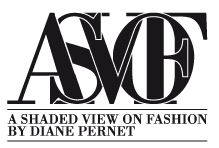Dear Shaded Viewers,
Death Becomes Her: A Century of Mourning Attire, The Costume Institute’s first fall exhibition in seven years, will be on view in The Metropolitan Museum of Art’s Anna Wintour Costume Center from October 21, 2014 through February 1, 2015. The exhibition will explore the aesthetic development and cultural implications of mourning fashions of the 19th and early 20th centuries. Approximately 30 ensembles, many of which are being exhibited for the first time, will reveal the impact of high-fashion standards on the sartorial dictates of bereavement rituals as they evolved over a century.
With the reopening of The Costume Institute space in May as the Anna Wintour Costume Center, the department returns to mounting two special exhibitions a year, to again include a fall show, in addition to the major spring exhibition. This is the first fall exhibition The Costume Institute has organized since blog.mode: addressing fashion in 2007. I was very happy to participate in that one with an afternoon at the Met with the Sartorialist and Cathy Horyn. It is hard to believe seven years have already gone by.
“The predominantly black palette of mourning dramatizes the evolution of period silhouettes and the increasing absorption of fashion ideals into this most codified of etiquettes,” said Harold Koda, Curator in Charge of The Costume Institute, who is curating the exhibition with Jessica Regan, Assistant Curator. “The veiled widow could elicit sympathy as well as predatory male advances. As a woman of sexual experience without marital constraints, she was often imagined as a potential threat to the social order.”
The exhibition will feature mourning dress from 1815 to 1915 primarily from the Costume Institute's collection. The Anna Wintour Costume Center’s Carl and Iris Barrel Apfel Gallery will orient visitors to the exhibition with fashion plates, jewelry, and accessories. The main Lizzie and Jonathan Tisch Gallery will illustrate the evolution of mourning wear through high fashion silhouettes and will include mourning gowns worn by Queen Victoria and Queen Alexandra. Examples of restrained simplicity will be shown alongside those with ostentatious ornamentation. The predominantly black clothes will be set off against a stark white background and amplified with historic photographs and daguerreotypes.
The Museum’s website, www.metmuseum.org, will feature information on the exhibition and related programs. Follow us on Facebook.com/metmuseum, Instagram.com/metmuseum, and Twitter.com/metmuseum. To join the conversation about the exhibition use #DeathBecomesHer on Instagram and Twitter.
1. Mourning ENsemble, 1870-1872 Black silk crepe, black mousseline The Metropolitan Museum of Art, Brooklyn Museum Costume Collection at the Metropolitan Museum of Art, Gift of the Brooklyn Museum 2009; Gift of Martha Woodward Weber, 1930 Veil, ca 1875 gift of Roi White, 1984 photo: The Metropolitan Museum of Art by Karin Willis
2. Evening dress, ca 1861 Black moire silk, black jet, black lace lent by Roy Lengford photo:The Metropolitan Museum of Art by Karin Willis,
3. Mourning Dress, 1902 – 1904 Black silk crepe, black chiffon, black taffeta.The Metropoitan Museum of Art, Gift of the New York Historical Society, 1979 photo: The Metropolitan Museum of Art by Karin Willis
4. Mourning Dress (detail), 1902-1904 black silk crape, black chiffon, black taffeta The Metropoitan Museum of Art, Gift of the New York Historical Society, 1979 photo: The Metropolitan Museum of Art by Karin Willis
5. Henriette Favre (French) evening Dress, 1902 Mauvre silk tulle sequins The Metropoitan Museum of Art, Gift of Miss Irene Lewisohn, 1937 photo: The Metropolitan Museum of Art
6. The "Black Ascot," 1910 Courtesy of The Metropolitan Museum of Art, Getty Images



